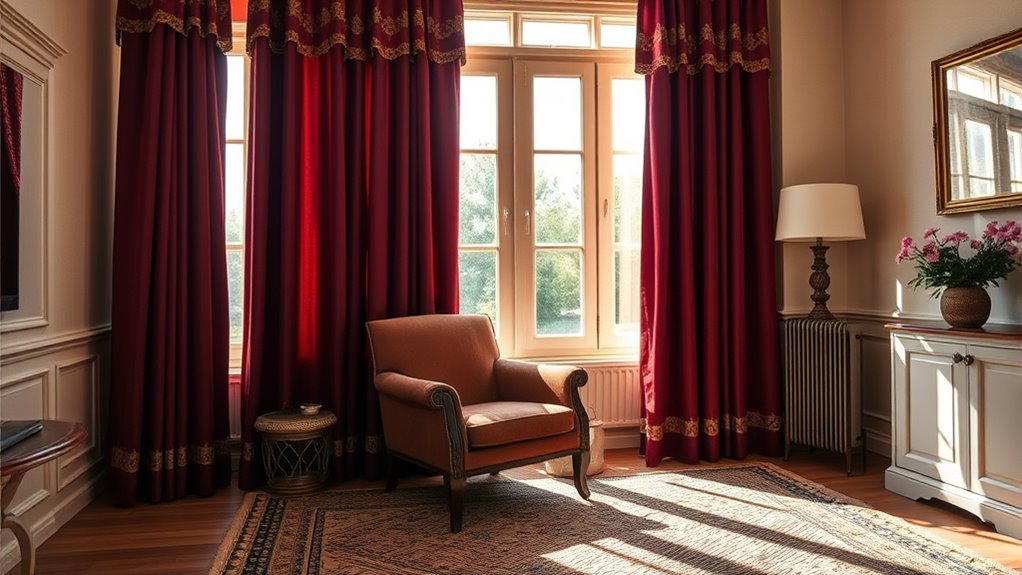Insulated curtains really do help keep heat in your home. Their layered design, with foam and reflective layers, acts as a barrier against heat transfer, trapping warmth during winter and blocking out heat in summer. They also seal gaps around your windows, reducing drafts and heat loss or gain. This can lower your energy bills and improve comfort year-round. If you want to learn more about how these curtains work and their additional benefits, keep exploring the options available.
Key Takeaways
- Insulated curtains are designed with multiple layers, including foam and reflective materials, to effectively trap heat inside.
- They can reduce heat loss by up to 60%, especially with proper sealing around window frames.
- In winter, insulated curtains help retain indoor warmth, lowering heating needs and energy costs.
- Their reflective layers bounce sunlight, reducing heat gain during summer and keeping rooms cooler.
- Proper installation and maintenance are essential for maximizing their heat retention capabilities.

Have you ever wondered how to keep your home warmer in winter and cooler in summer without constantly adjusting your thermostat? Insulated curtains might be just what you need. These curtains are designed with multiple layers, such as foam, thick fabrics, and reflective layers, to effectively reduce heat transfer through your windows. When winter hits, insulated curtains trap warmth inside, preventing heat from escaping. Thick fabrics and foam layers act as barriers, blocking cold air from sneaking in and reducing drafts. This means your heating system doesn’t have to work as hard, helping you save on energy bills. In fact, insulated curtains can cut heat loss by up to 60% in single-glazed windows and 40-50% in double-glazed ones, making a noticeable difference in comfort and cost savings. They keep your rooms cozy, even when it’s freezing outside, by sealing gaps around your windows and stopping heat from leaking out. Their layered construction enhances their insulating capabilities, making them a reliable choice for year-round temperature control.
During summer, insulated curtains work just as effectively by reducing heat gain. Light-colored options are especially good at reflecting sunlight away, lowering the amount of heat that enters your home—up to 33% in some cases. Many insulated curtains use reflective backing or vapor barriers that bounce sunlight back, keeping your indoor space cooler. They help minimize the load on your air conditioner, which means you can enjoy a more comfortable environment without cranking up the AC constantly. This not only improves comfort but also lowers energy costs during the hotter months. Because of their ability to block heat and sunlight, insulated curtains are valuable year-round. They help maintain stable indoor temperatures, reduce reliance on heating and cooling systems, and ultimately save you money on utility bills.
Choosing the right type of insulated curtains depends on your needs. Thermal curtains are excellent for winter, focusing on heat retention, while heat-blocking curtains are better for sun-facing windows to prevent heat gain in summer. Many designs are multipurpose, suitable for use throughout the year by switching or adjusting layers. Proper installation is key—your curtains should rest tightly against window frames to create an effective seal and maximize their insulating properties. Regular cleaning and maintenance will keep them functioning at their best, and they can also add aesthetic value to your décor. Besides temperature control, insulated curtains also help reduce noise pollution, creating a quieter, more peaceful environment. They prevent drafts and help stabilize indoor temperatures, making your home more comfortable regardless of the season. Overall, insulated curtains are a smart investment that delivers consistent energy savings and comfort, proving that they do indeed keep heat in when you need it most.
Frequently Asked Questions
How Do Insulated Curtains Compare to Double-Glazed Windows?
You wonder how insulated curtains compare to double-glazed windows. While curtains are cheaper, easier to install, and flexible for seasonal use, they don’t provide as consistent or long-term insulation as double-glazed windows. Windows offer better year-round thermal performance and durability, but at a higher upfront cost. If you’re seeking quick, cost-effective heat retention, insulated curtains work well. For more permanent, efficient insulation, double-glazed windows are the superior choice.
Can Insulated Curtains Be Used in Outdoor Settings?
Think of outdoor insulated curtains as a weather-resistant shield for your space. Yes, you can use them outdoors—they’re designed with thicker, multi-layer fabrics that block wind, rain, and UV rays. You’ll find they create a cozy barrier, reducing heat loss in winter and reflecting sunlight in summer. Reinforced with durable seams and waterproof coatings, these curtains turn open areas into comfortable, energy-efficient spaces year-round.
Are There Eco-Friendly Options for Insulated Curtains?
You’ll find plenty of eco-friendly options for insulated curtains that suit your sustainability goals. Materials like organic hemp, bamboo, and recycled polyester are popular choices, offering durability and insulation without harming the environment. These fabrics are renewable, require less water and pesticides, and help reduce waste. Plus, they add a natural aesthetic to your home while improving energy efficiency, making them a smart, eco-conscious choice for your insulation needs.
How Long Do Insulated Curtains Typically Last?
Curious about curtain longevity? Typically, insulated curtains last between 10 to 15 years if cared for properly. You can prolong their life by regular dusting, gentle cleaning, and avoiding harsh chemicals. Keep in mind, durability depends on fabric type, exposure to sunlight, and environmental factors. With mindful maintenance, your insulated curtains will maintain their magic, maximizing warmth and minimizing wear, year after year.
Do Insulated Curtains Affect Room Humidity Levels?
You might wonder if insulated curtains affect your room’s humidity. They don’t directly change moisture levels but can influence air circulation, especially if poorly sealed. Reduced airflow can trap moisture, leading to increased humidity or condensation on windows. To prevent this, guarantee proper sealing, select moisture-resistant fabrics, and maintain good ventilation. Balancing insulation with airflow helps keep your indoor humidity comfortable and prevents mold or mildew buildup.
Conclusion
So, as you consider insulated curtains, remember the wisdom of the ancients who valued warmth and comfort. Like a mythical shield protecting a fortress, these curtains can help keep your home cozy and energy-efficient. While they won’t work miracles, they certainly offer a practical layer of defense against the cold. Embrace this simple upgrade, and you’ll find your space more inviting—turning your home into a sanctuary, much like the legends of old guarding their treasures.









